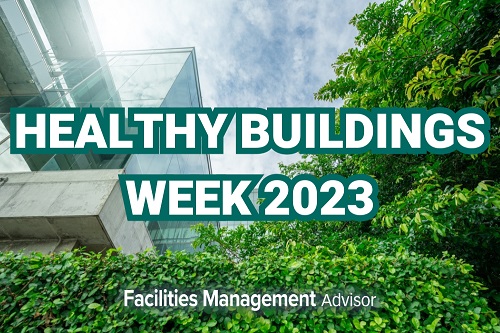Held the week of Aug. 14-18, Facilities Management Advisor‘s Healthy Buildings Week 2023 featured information about how keeping facilities healthy has a major positive impact on occupants, thereby increasing productivity. If you missed any of the webinars, here’s a rundown with key takeaways and links to FREE on-demand recordings.

Educational Session | The Evolution of WELL: How to Leverage the WELL Health-Safety Rating for Facilities Operations and Management
Speaker: Angela Spangler, Senior Director of Global Market Development, International WELL Building Institute
Key Takeaways: Spangler explained that the International WELL Building Institute (IWBI) is a global authority for transforming people’s physical, mental, and social well-being. It is important for facilities to follow the WELL healthy road map so that they can not only lower levels of stress and burnout among occupants, but also secure and retain top talent.
She said that there are 10 different concept areas that can help improve the health of people in facilities:
- Mind
- Community
- Movement
- Water
- Air
- Light
- Thermal Comfort
- Nourishment
- Sound
- Materials
COVID-19 brought wellness to the forefront for everyone, including employers, which led to even more organizations deciding to meet WELL standards.
“There are plenty of different signposts along this road map that you can go and achieve these different types of accomplishments within the WELL ecosystem,” said Spangler, adding that these include scales, ratings, and certifications.
Watch the full webinar on-demand here.
Educational Session | Designing Healthy Spaces with Biophilic Design
Speaker: Kelly Walowski, Global Account Development, Ambius
Sponsor: Ambius
Key Takeaways: Walowski discussed the importance of implementing biophilic design in facilities. Biophilic design allows the integration of key elements of nature into facilities, strengthening the human-nature connection. Integrating this design helps calm people down so they can communicate better, process things better, and sleep better, all of which lead to better productivity.
She explained that integrating biophilic design to create healthy spaces in facilities is even more important today as stress, mental health issues, and crime continue to increase, affecting the health of employees.
Walowski highlighted 9 biophilic concepts that have the biggest impact:
- Vegetation
- Refuge and shelter
- Sound
- Connections with the exterior
- Overlooking a landscape
- Natural materials
- Light
- Scents
- Water
“Research shows that when organizations support the health of their most valuable assets, people, they often experience lower turnover and burnout as well as greater productivity and engagement, driving improvements for their bottom line,” she said.
To learn more, check out Ambius’s Biophilic Design Trends 2023 report by clicking here.
Watch the full webinar on-demand here.
Educational Session | ASHRAE Standards for Control of Infectious Aerosols: Improving Clean Airflow Rates
Speaker: Larry Rothenberg, President, Agentis Air, LLC
Sponsor: Agentis Air
Key Takeaways: Rothenberg discussed the new American Society of Heating, Refrigerating, and Air-Conditioning Engineers (ASHRAE) Standard 241 for the control of infectious aerosols to reduce the risk of disease transmission in facilities. This new standard was created to help reduce COVID-19 exposure.
Previously, ASHRAE indoor air quality standards focused mainly on bringing outdoor air into facilities, and these were not sufficient in warding off disease transmission.
The new standard has several major components, including:
- Infection Risk Management (IRMM)
- Requirements for equivalent clean airflow rate
- Requirements for use of filtration and air cleaning technology
- Planning and commissioning
“It allows for a lot of flexibility, and this flexibility is important because we have a lot of technologies coming on the market. What we saw during COVID is that people want to be able to address this concern in a way that is responsive to the needs of the occupants,” Rothenberg said.
Solutions should be customized based on facility type and size, as well as the number of occupants.
To learn more, check out Agentis Air’s white paper by clicking here.
Watch the full webinar on-demand here.
